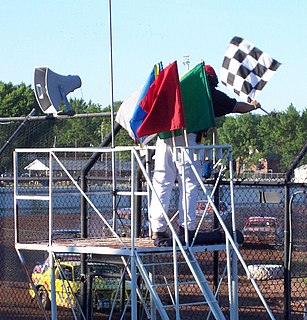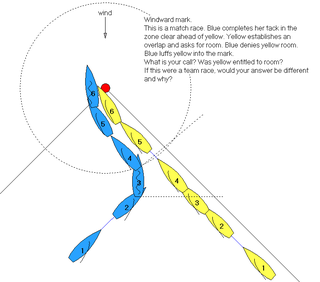 W
WA diver down flag, or scuba flag, is a flag used on the water to indicate that there is a diver below. Two styles of flag are in use. Internationally, the code flag alfa/alpha, which is white and blue, is used to signal that the vessel has a diver down and other vessels should keep well clear at slow speed. In North America it is conventionally red with a white stripe from the upper left corner to the lower right corner.
 W
W"England expects that every man will do his duty" was a signal sent by Vice-Admiral of the Royal Navy Horatio Nelson, 1st Viscount Nelson from his flagship HMS Victory as the Battle of Trafalgar was about to commence on 21 October 1805.
 W
WFlag semaphore is a semaphore system conveying information at a distance by means of visual signals with hand-held flags, rods, disks, paddles, or occasionally bare or gloved hands. Information is encoded by the position of the flags; it is read when the flag is in a fixed position. Semaphores were adopted and widely used in the maritime world in the 19th century. It is still used during underway replenishment at sea and is acceptable for emergency communication in daylight or using lighted wands instead of flags, at night.
 W
WHornby Lighthouse, also known as South Head Lower Light or South Head Signal Station, is a heritage-listed active lighthouse located on the tip of South Head, New South Wales, Australia, a headland to the north of the suburb Watsons Bay. It marks the southern entrance to Port Jackson and Sydney Harbour, as well as lighting the South Reef, a ledge of submerged rocks. It is the third oldest lighthouse in New South Wales. Designed by Mortimer Lewis and listed on the Register of the National Estate and on the New South Wales State Heritage Register since 2 April 1999, with the following statement of significance:A dominant Sydney landmark which appears to have been in continuous use since the 1840s as a controlling point for shipping entering and leaving Port Jackson. The building complex, designed by the Colonial Architect Mortimer Lewis in the early 1840s, is an architectural important example of an early Victorian public work associated with port activities.
 W
WThe International Code of Signals (ICS) is an international system of signals and codes for use by vessels to communicate important messages regarding safety of navigation and related matters. Signals can be sent by flaghoist, signal lamp ("blinker"), flag semaphore, radiotelegraphy, and radiotelephony. The International Code is the most recent evolution of a wide variety of maritime flag signalling systems.
 W
WThe international inspection pennant is an international flag for fisheries inspection vessels currently used by the fisheries inspection branches of the European Union, France, New Zealand and Norway. It is also used by various FIRMS member organisations such as the NEAFC, NAFO and ICSEAF.
 W
WInternational maritime signal flags are various flags used to communicate with ships. The principal system of flags and associated codes is the International Code of Signals. Various navies have flag systems with additional flags and codes, and other flags are used in special uses, or have historical significance.
 W
WRacing flags are traditionally used in auto racing and similar motorsports to indicate track condition and to communicate important messages to drivers. Typically, the starter, sometimes the grand marshal of a race, waves the flags atop a flag stand near the start/finish line. Track marshals are also stationed at observation posts along the race track in order to communicate both local and course-wide conditions to drivers. Alternatively, some race tracks employ lights to supplement the primary flag at the start/finish line.
 W
WThe Racing Rules of Sailing govern the conduct of yacht racing, windsurfing, kitesurfing, model boat racing, dinghy racing and virtually any other form of racing around a course with more than one vessel while powered by the wind. A new revision is published every four years by World Sailing, the sport's world governing body. Full information on the rules can be downloaded at World Sailing.
 W
WThe Sydney Observatory is a heritage-listed meteorological station, astronomical observatory, function venue, science museum, and education facility located on Observatory Hill at Upper Fort Street, in the inner city Sydney suburb of Millers Point in the City of Sydney local government area of New South Wales, Australia. It was designed by William Weaver (plans) and Alexander Dawson (supervision) and built from 1857 to 1859 by Charles Bingemann & Ebenezer Dewar. It is also known as The Sydney Observatory; Observatory; Fort Phillip; Windmill Hill; and Flagstaff Hill. It was added to the New South Wales State Heritage Register on 22 December 2000.
 W
WWigwag is an historical form of flag signaling that passes messages by waving a single flag. It differs from flag semaphore in that it uses one flag rather than two, and the symbols for each letter are represented by the motion of the flag rather than its position. The larger flag and its motion allow messages to be read over greater distances than semaphore. Messages could be sent at night using torches instead of flags.